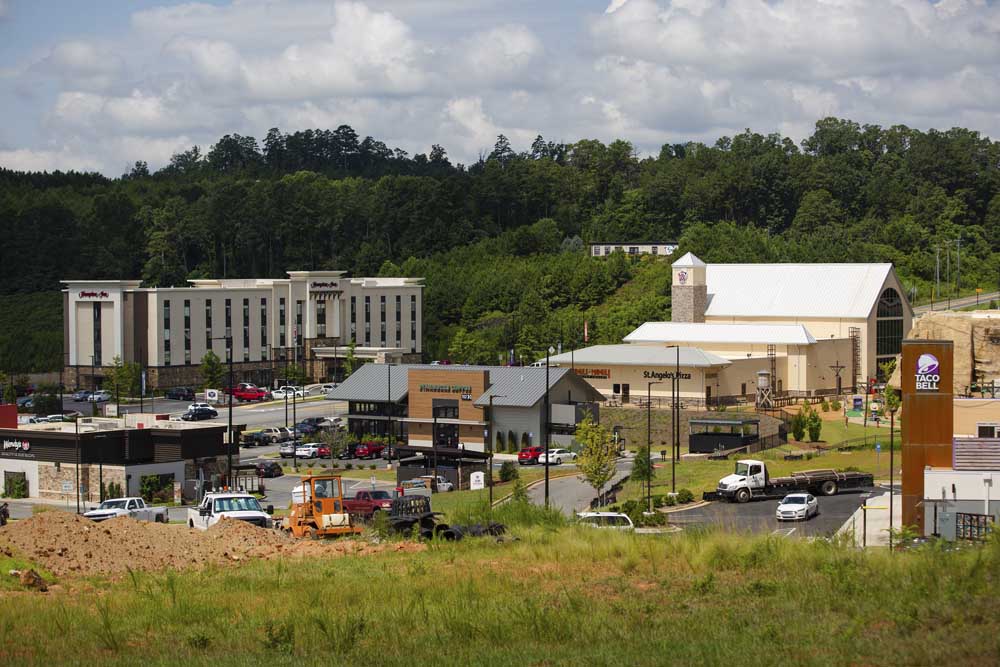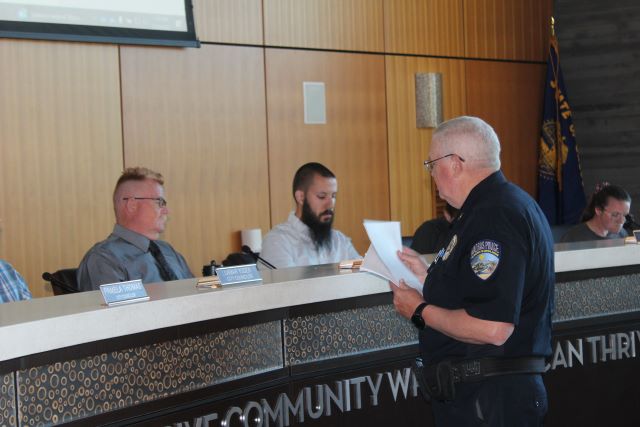The mega-complex comes to town
Published 12:00 am Monday, September 17, 2018

- Hotels and restaurants cluster around LakePoint Sporting Community in Emerson, Ga., July 25, 2018. Tournament organizers, property developers and a handful of small towns have created a network of megacomplexes to court travel teams, athletes and parents. (Kevin D. Liles/The New York Times)
EMERSON, Ga. — Just past the Hampton Inn and the Chick-fil-A, beyond the climbing wall but not as far as the water park, is your field of dreams. Actually, there are eight of them: all major league-sized, synthetic-turfed and LED-lit, and wedged in next to the three soccer pitches. The Champions Center is ahead on your left, where a dozen basketball courts can be converted into two dozen for volleyball.
It is here at the LakePoint Sporting Community where the visiting boys and girls in their cleats and their uniforms have come to play, with their parents trailing them from the diamonds and the hardwood to the fast-food restaurants and the hotels. In the summer, hundreds of teams pass through here every week.
Trending
The youth sports economy — a world of private coaching, interstate travel and $350 baseball bats — has always been big business, of course. But fed by the growth of traveling teams and regional and national events, the industry has doubled in size over the past decade — to more than $15 billion a year, according to one company that tracks its growth — as tournament organizers, property developers and a small number of small towns target parents who share their young athletes’ dreams of glory and have the money to pursue them.
As families travel more miles so their children can play more games and be seen by more college recruiters, sprawling complexes like The Grand Park Sports Campus in Westfield, Indiana, Rocky Top Sports World in Gatlinburg, Tennessee, and LakePoint have fine-tuned both their facilities and their programs to attract millions of visitors every year. And as they have succeeded, these megacomplexes — and other hybrid sports/vacation destinations like them — have become staples of yet another growing youth sports phenomenon: the tourna-cation circuit.
“The plan is to be like a cruise ship for youth sports,” said Bob Zurcher, the chief financial officer of LakePoint Land, which has helped turn Emerson, a town of 1,500 about 40 miles north of Atlanta, into an unlikely year-round tourist destination. “You give them first-class competition and facilities, then try to give them everything else they need right here.”
A study published by Utah State University in 2014 found that American families spent an average of $2,292 each year on youth sports. But it also found many households that spent as much as 10.5 percent of their gross income annually — sometimes $20,000 or more — on personal trainers, travel costs and private teams for their children.
“They may be holding back on vacation or on a car, but they will make certain that Susie goes to the cheerleading competition in Orlando and Johnny gets to his Little League tournament in Georgia,” said Mary Helen Sprecher, the managing editor of Sports Destination Management, a trade publication for event managers and rights holders. “These youth complexes have become part of the sports ecosystem by putting heads in beds, filling up restaurants and delivering economic impact.”
The miles, and the costs, can add up quickly. The Peach State Basketball Classic at LakePoint in July, for example, was only a midseason stop for Scott Wyatt and his 16-year-old daughter Claire. Her team, the Tennessee Fury, was coming from a girls tournament in Louisville, Kentucky, that had attracted more than 800 squads, and it would head to an event in Atlanta a few days later.
Trending
Wyatt, a pharmacist in Knoxville, Tennessee, stayed with his wife and daughter at the Holiday Inn, as the tournament required. The Fury’s game schedule was tight, which meant the families’ meal options were largely limited to the Taco Bell or the Chick-fil-A or the pizza restaurant near the complex. LakePoint officials said out-of-town visitors spend an average of $122 per person a day; for locals, it is about half that.
Over two nights and three days, Wyatt said, his family expected to spend about $800 here, or about one-third the $2,550 their trip to Louisville had cost. The three-day tournament in Atlanta that followed would add more to their tab. Toss in an earlier trip to Raleigh, North Carolina, and Wyatt estimated that the summer travel basketball schedule for Claire, a 6-foot-1 junior, would cost the family about $6,000.
“We’re trying to get college scholarships — that’s the only reason we are here,” Wyatt said. “The whole goal to get these girls in a school and some of it paid for.”
The Peach State Basketball Classic was considered a boutique exposure tournament for the nearly 100 teams that participated, and there were college coaches carrying clipboards roaming the special lanes between courts reserved for them — set up to allow them to watch players away from parents. The coaches wore shirts bearing the logos of every kind of program: Bible colleges and Ivy League universities, big state schools and small liberal arts institutions. Signs for scouting services and sneaker companies surrounded the courts.
Earlier in the year, the big shoe companies — Nike, Adidas and Under Armour — all had hosted top-tier boys tournaments here that drew some of the biggest names in college basketball: Duke coach Mike Krzyzewski, Kentucky’s John Calipari, Villanova’s Jay Wright. Russell Westbrook of the Oklahoma City Thunder turned up to check in on an AAU team that he sponsors, and Dwyane Wade came to watch one of his sons play.
Other weeks, the complex’s focus switches effortlessly between baseball and volleyball, soccer and cheerleading.
Potential payoff
For the players and their parents, though, the potential payoff is worth the sizable investment of time and money. NCAA member universities hand out about $3 billion in scholarships a year. And while the organization reminds parents that only 2 percent of high school athletes are awarded athletic scholarships, the pursuit of even a microscopic share of those billions continues to drive the youth sports economy.
Disney was among the first to recognize this emerging market, and in 1997 it dived in by creating the ESPN Wide World of Sports Complex on the grounds of its Disney World theme park in Orlando, Florida. The 220-acre complex has nine venues — including a tennis center, outdoor fields, indoor courts and field houses — and hosts annual events like the Pop Warner football and national cheer and dance championships.
In 2016, the Wide World of Sports complex drew more than 385,285 athletes, a 28 percent increase since 2011. But perhaps just as important to Disney was that the athletes and their families stayed in Disney hotels, ate at Disney restaurants, rode on Disney rides and luxuriated in Disney spas — and that the investment in sports facilities was introducing another generation of children to the company’s brands. In the years that followed, imitators popped up in amusement park towns like Sandusky, Ohio, and tourist destinations like Myrtle Beach, South Carolina.
Entering the market was a steeper climb, however, for communities like Emerson, in Bartow County, where the youth sports facilities had to be built from scratch — along with the infrastructure and every other supporting business and service.
Peter Olson, the county administrator, recalled the original developers’ offering a succinct pitch for the 1,300 acres here along Interstate 75. “We’ll build the ocean,” Olson said they told him, “and then the beach will be valuable.”
‘Skin in the game’
The county offered the developers a tax abatement for 10 years and financed the Champions Center with $36 million in bonds from its development authority. Since opening in 2014, more than 3 million visitors from all 50 states have come to play here, producing what the county said was an annual economic impact of $97.4 million. Food, bar and hotel revenue in the county, Olson said, was up 80 percent.
“We have some skin in the game,” he said.
There also have been some missteps. Building a massive youth sports development is a capital-intensive project, and the original investors ran out of cash after only 100 acres had been developed. In June, a hedge fund based near Los Angeles, Rimrock Capital Management, took the complex into Chapter 11 bankruptcy and, as the primary creditor, decided to try to turn its debt into equity.
“They are doubling down,” said Dan Berman, a senior managing director of GlassRatner Advisory & Capital Group, the Atlanta-based firm Rimrock brought in to restructure the deal.
With more than $100 million already at work, a priority is more hotels and restaurants: Signs marking the future homes of a Holiday Inn Express and a Spring Hill Suites stand alongside the bulldozers creating the roads that will connect them with the sprawling LakePoint complex. Berman said more sports facilities were a certainty, but Rimrock is also exploring more options, like added amusement attractions and a convention center.
In the meantime, and with summer over, lacrosse and soccer tournaments and flag football leagues are expected to keep the outdoor fields busy through the spring. The Champions Center is booked through next summer with cheerleading competitions and volleyball, basketball and futsal tournaments.
With new youth sports complexes popping up throughout the nation, including two projects in neighboring Alabama, Dean Keener, a senior vice president who helps manage the indoor facilities, said the youth sports industry had become as competitive — and as potentially lucrative — as his old profession: He is the former men’s basketball coach at James Madison University.
“It’s a lot like college recruiting,” Keener said. “You’ve got to sleep with one eye open.
“You sign someone and you may be on to the next recruiting class, but these complexes continue to go up and you can’t rest on what you’ve done or you’ll be out of business.”








